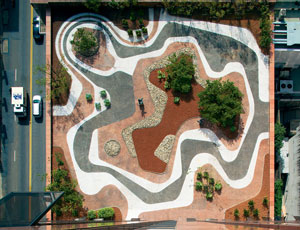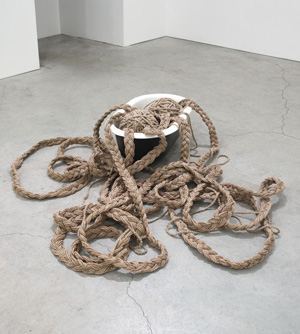Crafting the Middle Class
John Haberin New York City
Crafting Modernity: Design in Latin America
Weaving Abstraction and the Andes
"Crafting Modernity" tells a familiar story, about a world torn apart and renewed by Depression and world war. Only one thing: this time it unfolds with a tapestry, a table, and a chair—and on another continent entirely. Make yourself at home.
You know the story, about modern life and modern art. As recovery looked more and more urgent and more possible, it brought not a revival of the gilded age, but a home life that many more could call their own. Middle-class comforts included much that could not have existed before the twentieth century.  Renowned artists and designers embraced the cause, with furnishings that many more could afford, without the stifling air of Edwardian wallpaper. In no time, capitalism made that cause a consumer revolution, as craft gave way to new technologies and new pressures to spend. If it thus took back its own promises, it sound surprisingly like change today—only centered not on Asia, Silicon Valley, or Madison Avenue, but Latin America at the Museum of Modern Art.
Renowned artists and designers embraced the cause, with furnishings that many more could afford, without the stifling air of Edwardian wallpaper. In no time, capitalism made that cause a consumer revolution, as craft gave way to new technologies and new pressures to spend. If it thus took back its own promises, it sound surprisingly like change today—only centered not on Asia, Silicon Valley, or Madison Avenue, but Latin America at the Museum of Modern Art.
There are moments in "Weaving Abstraction" that feel suspended between centuries. If MoMA seeks the origins of modernity in the aftermath of World War II, the Met reaches back to antiquity. Yet it ends in much the same years and much the same artistic circles. Are they telling the same story after all? The Met's mere handful of recent artists can hardly encapsulate weaving or abstraction. Their pairing with art of the Andes has its own suspense nonetheless.
From craft to commerce
If you have heard this story before, it may well be at MoMA as well. In 2015 it presented the same four decades of Latin American architecture, ending around 1980. You may recognize Oscar Niemeyer and Lina Bo Bardi, whose architecture appears along with others projected on the walls, as a backdrop for what might have stood inside. Here, though, they contribute furniture—Niemeyer a low table, suitable for stacking or a communal meal on the floor. Bo Bardi brings quite an array of chairs. Roberto Burle Marx, who with Niemeyer created buildings for the new capital city of Brasilia, has a painting, like a sketch toward the new interior design.
The Met is out to extend what one even means by design. Gego appears not for her wire sculpture, but for wiry white diagonals on a huge hanging. Olga de Amaral, also with art of the Andes now at the Met, and Cynthia Sargent display fabric as well. Here, though, it appears not as art for itself but tapestry for the home. The filmed architecture, in turn, sticks to homes, not to massive public projects. It is remaking modern life one family at a time.
Still, it is remaking private life in public. Chairs appear by far the most often, not bedroom furniture, and films focus on exteriors and common spaces. The International Style favored slim columns and glass houses, which allow one to look out on nature, but also allow others to look in. The curators, Ana Elena Mallet and Amanda Forment, feature just six countries, to give their distinct traditions their due. At least one artist claims to draw on pre-Colombian art, but be careful. One might just as well speak of global art in a newly global economy.
A long wall diagrams each country's social networks, like maps of the art world for Mark Lombardi. They testify instead to interactions and displacement. Naturally they include Josef Albers, Anni Albers, and others from the Bauhaus, but also Alexander Calder, Black Mountain College in New England, and ever so much more. In the show as a whole, artists can trace their origins to a dozen European nations and the United States. But you have heard that story before, too, about refugees from fascism who helped create postwar art. No wonder furniture had an eye to portability and reassembly in the face of exile—like Niemeyer's Modulo, a "puzzle chair," or lounge furniture from Roberto Matta that fits neatly together as a square.
Assembly and repetition also encourage the shift from craft to brand names. Antonio Bonet, Juan Kurchan, and Jorge Ferrari Hardoy (later Grupo Austral) gave their initials to the B.K.P. chair, a descendant of the Marcel Breuer chair with its tube frame and suspended leather. They conceived it not in Argentina, but in the Paris studio of Le Corbusier—and copies quickly entered Fallingwater, the Frank Lloyd Wright house, and the Museum of Modern Art. International enough for you? MoMA provided another spur to invention with a 1940 design competition. Several of the chairs look out on the museum's sculpture garden now.
Both threads, craft and commerce, offer surprises. Other brand names include a logo for Olivetti typewriters. Ceramics, as with Colette Boccari, may depart from a perfect circle, as if fresh from the oven, without losing their subtle color. High tech can have an industrial look, too, like flashlights by Emilio Ambasz that could pass in reproduction for pipes. Much the same red plastic enlivens a bar cart, an ice bucket, and a TV. Sit down, turn on, and pour yourself a drink.
Bob and weave
At the Met, the exhibition's full title speaks of "ancient and modern." Centered on the Andes from as much as twenty-seven hundred years ago, it unfolds in space otherwise dedicated to modern and contemporary art. About halfway through, a panel could almost be a direct response to Minimalism. Its thousands of feathers affixed to cotton strings form a thick, soft surface that divides neatly into four rectangles, alternating between light yellow and blue. More yellow flecks the blue, as if about to take flight. Like the Post-Minimalism of Eva Hesse, it might be an extension of an animal or human body—or the human imagination.
The show features four women who came to prominence in just the last century, and they may feel suspended not just in time, but also in place. Anni Albers took up fabric at the Bauhaus but fled to America in 1933 and worked for sixty more years in exile. Sheila Hicks studied with her husband, Josef Albers, at Yale. Lenore Tawney studied with another refugee from the Bauhaus before joining the "fabric art" movement along with Olga de Amaral. What seems at first like a sprinkling of recent art, for contrast and relevance, gathers momentum over the course of a long room. By the show's end, it has come to the very brink of the present.
It may seem like a mere excuse to approach either the present or the past—a routine excuse at that. More and more, museums are insisting on other times and other cultures, like Cycladic art at the Met. The museum has been slipping contemporary art into older contexts as well, like Korean art. More and more, too, artists have been turning to tapestries and fabric as their means of painting.  It can serve as a further call for diversity, as well, to recognize "women's work." And now the Met heads to not just the rural South, but to the arid hills of South America.
It can serve as a further call for diversity, as well, to recognize "women's work." And now the Met heads to not just the rural South, but to the arid hills of South America.
But is there truly, as the Met puts it, an "Andean legacy"? The Bauhaus had its mission to promote craft as art, as a model for design. Albers did visit an ethnological museum back in Berlin. Yet her austere patterns have more to do with Modernism than ancient checkerboards. Hicks does not so much as take up weaving, although her dyes have parallels in ancient art. Her loose strands or the slits in Tawney's slim black hangings, almost like gowns, may recall ancient "open looms."
Peru is harder still to pin down, and the curators, Iria Candela and Joanne Pillsbury, make no attempt at chronology. They open with rich color from perhaps the 1500s, in a tunic of red and gray, before doubling back a millennium before to a coiled headband—and then further back to mystery figures from before the present era, their slim black tongues sticking out from sharp teeth beneath wild eyes. No wonder historians cannot assign many works to a single century, not when the culture left no written records. One cannot know when clothing served for necessity, for kings, for votive offerings, for gifts to secure peace, or for exchange. One cannot know either whether women produced a single one. One can know the lack of the very idea of abstraction.
Still, the Met is on a mission, too—to introduce the ancient and Incan cultures that the Spanish killed off. It is also insisting on women artists. de Amaral broadens fabric beyond what the Andes ever knew, with gold leaf, paper, and gesso on a "gridded wall." Hicks is lushest and most varied of all, from densely curving colors to bare white descending in tassels as her Linen Lean-To. Its cryptic patterns may suggest an unknown language. But then the knots in ancient khipus may have communicated something, too.

"Crafting Modernity" ran at The Museum of Modern Art through September 22, 2024, "Weaving Abstraction" at The Metropolitan Museum of Art through June 16.




